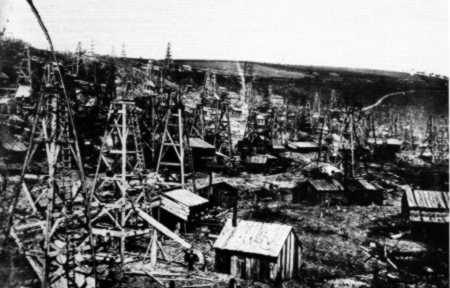| |
5.1 Anarchy of the first drillings
.
 |
John Benninghoff farm in Oil Creek, Pennsylvania where you can
see the anarchy of 1861 |
.
Before Mr. Rockefeller took the totality of this industry in his iron hand,
the price of oil fluctuated wildly. It soared or fell quickly, depending on the market
being flooded with an abundant supply or starved by a strong demand. In 1859 for example,
the crude oil barrel was selling for $20 and two years later only for 52 cents ...
Speculators bought huge quantities of crude after an especially generous well (a wildcat)
had made the prices go down (or knocked the bottom out of the market, in the
colorful English of the oilmen) and stored it in tanks, waiting for the prices to rise
again. To invest in such a business needed the temper of a gambler, which was not lacking
to these men.
5.2 Rockefeller's vision
|
<<We reached the conclusion that
there were three great divisions in the petroleum business - the production, the carriage
of it and the preparation of it for market. If any one party controlled absolutely any one
of those three divisions, it practically would have a very fair show of controlling the
others.>>
Colonel Potts in 1888 |
In a first stage, Rockefeller devoted himself to the conquest of the better part
of the refineries. He did not stop at this almost perfect horizontal concentration
of the refining business, though. He realized that by controlling the refining process, he
was the master of the whole industry, and worked from that point on to a vertical
concentration to the whole industry, taking over every stage of production, from
extraction to retail, including transport, research, marketing and even the manufacture of
barrels. This was an ambitious plan because of the fierce resistance of the staunchly
independent producers, and the great diversity of operations, but nevertheless he
succeeded above all hopes. At its peak, the Standard Oil owned not only all the
infrastructures necessary to the making of refined oil, but also pipelines, cars, tankers,
groceries. The few links that did not belong to it were in perfect monopsony situation,
with the Standard as only buyer. |
